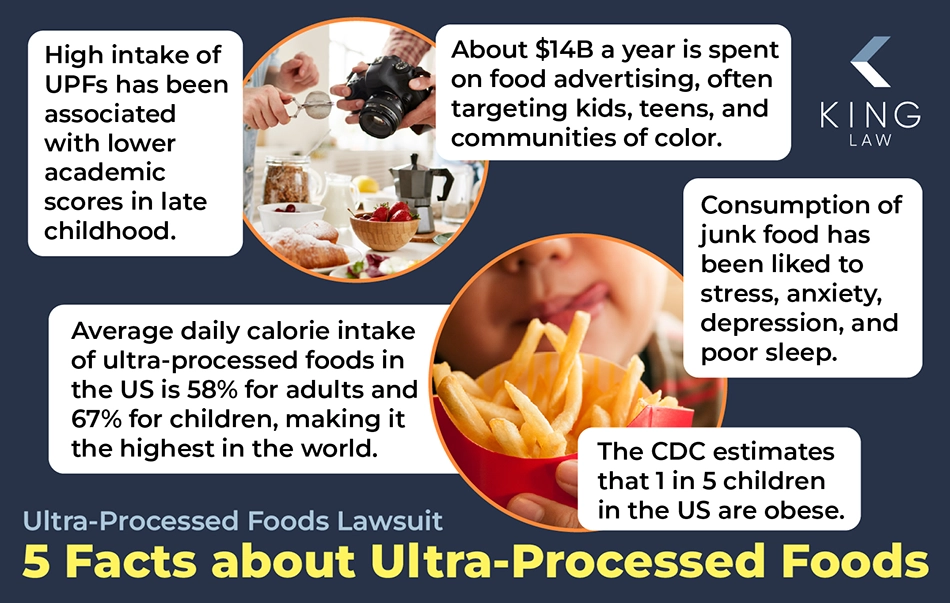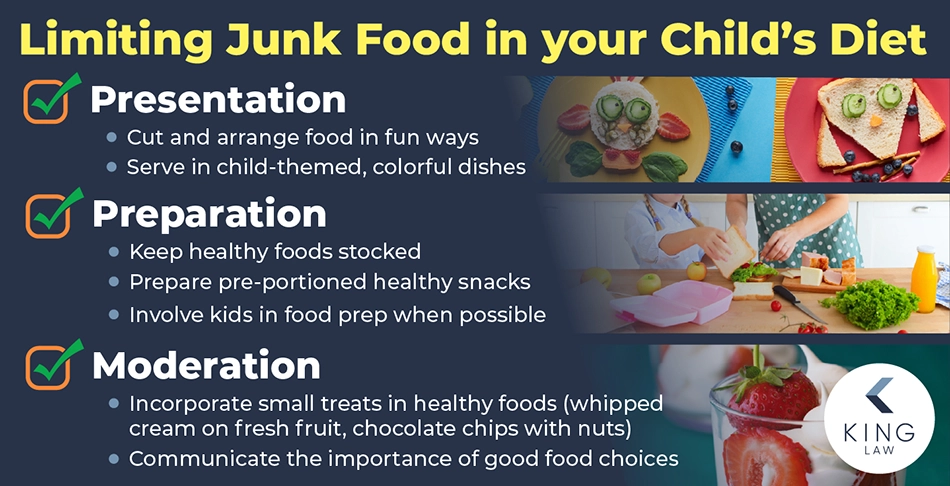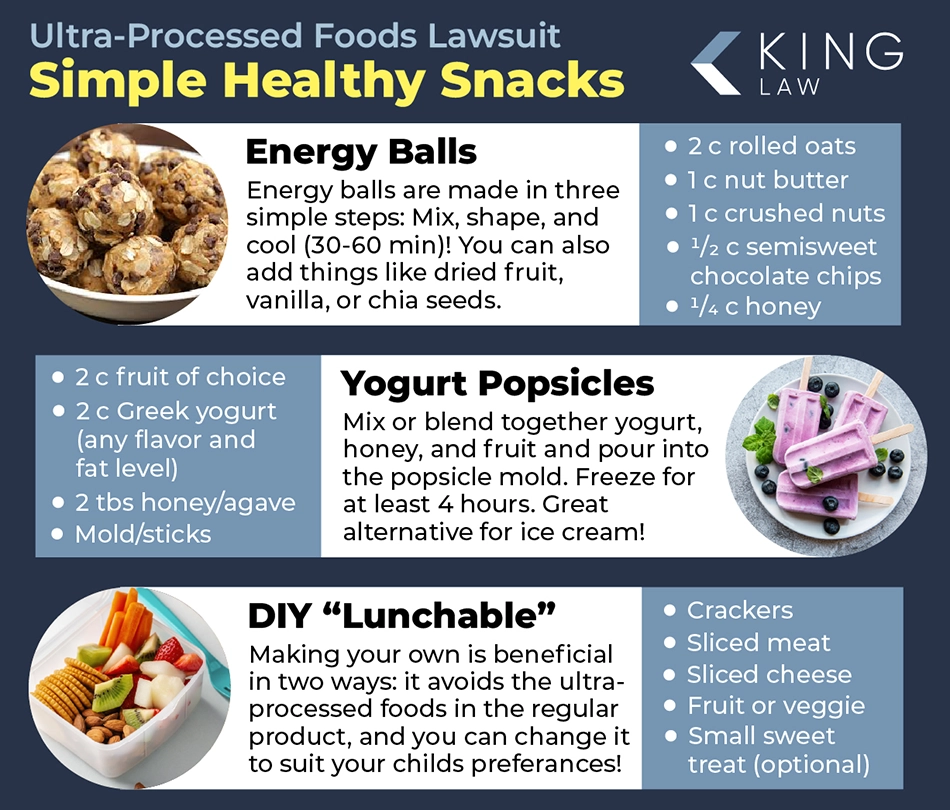
Junk foods frequently fall under the category of ultra-processed foods (UPFs). UPFs are foods that have undergone significant industrial processing and generally contain little to no nutritional value. They are often high in calories and contain a substantial number of synthetic additives that make them more appetizing.
Junk foods like pizza, cheeseburgers, candy, and chips tend to be high in salt and sugar, making them appealing to children. Junk food manufacturers also target children in their marketing with things like cartoon mascots, social media campaigns, and festive colors.
Many health experts believe the overconsumption of ultra-processed foods has led to obesity and other adverse health issues. The increase in consumption of junk foods and UPFs correlates with a rise in non-alcoholic fatty liver disease and type-2 diabetes in children. This page will share some facts about junk foods and ultra-processed foods and examine how consuming too many of these foods may harm children.
About Junk Food For Kids:
10 Facts About Junk Food and Kids
What Are the Harmful Effects of Junk Food For Kids?
Advertising Junk Foods to Kids
How to Make Kids Stop Craving Junk Food
What if My Child Has Already Been Harmed by Junk Food?
10 Facts About Junk Food and Kids
Junk foods and ultra-processed foods are a regular part of diets of many children throughout the world. The overconsumption of packaged snacks, sodas, fast food, and other ultra-processed foods has led to obesity and other chronic conditions. Research indicates the U.S. has the highest intake of ultra-processed foods in the world. Similarly, 20% of children in the U.S. are obese.
Here are 10 facts about junk food and the associated dangers for children:
- The U.S. has the highest intake of ultra-processed foods in the world, accounting for 58% of adults’ daily calorie intake and 67% of children’s daily calorie intake.
- Junk food or ultra-processed food is formulated to taste good, but it lacks the nutritional content to make people feel satisfied.
- Junk food is normally low in nutrients and fiber and often high in sugar, fat, and calories.
- Many junk foods contain additives, dyes, and colors.
- According to the Centers for Disease Control and Prevention (CDC), approximately 1 in 5 children in America is obese.
- Obese children are at a higher risk for debilitating health conditions, including asthma, sleep apnea, bone and joint problems, type 2 diabetes, and risk factors for heart disease such as high blood pressure.
- Food and beverage companies spend nearly $14 billion each year on advertising, with a large percentage marketed toward teens, children, and communities of color.
- Junk food consumption has been linked to depression, stress, anxiety, and sleep dissatisfaction in children and adolescents.
- Ultra-processed junk food can change the way a child’s brain works. Scientists are examining if these foods trigger an addictive process that drives compulsive intake.
- Consuming large amounts of fast food in fifth grade is associated with lower academic achievements in core subjects in eighth grade, even when confounding factors were controlled.

What Is Junk Food?
Junk foods are usually high in fat, salt, and sugar. These foods are known as High fat, salt, and sugar foods (HFSS foods), and they often contain little to no nutrients despite being high in calories. In addition to being an HFSS food, junk food is typically highly refined or contains highly refined ingredients. Fast food, packaged snacks, sodas, candy, and other commercially manufactured foods fall under this category. Many HFSS also contain preservatives, colorings, and flavorings.
How Junk Foods Are Classified (The Nova Classification System)
The NOVA Food Classification System was designed by the Center for Epidemiological Studies in Health and Nutrition, School of Public Health, University of Sao Paulo, Brazil. The NOVA system groups foods into four categories: unprocessed or minimally processed foods, processed culinary ingredients, processed foods, and ultra-processed foods.
The NOVA Food Classification System:
- Unprocessed or minimally processed foods: These foods have undergone little to no processing and generally retain their natural form. The only processing usually involves cleaning, grinding, freezing, or removing inedible parts. This kind of food includes eggs, coffee, dried fruits, and lentils.
- Processed culinary ingredients: These foods include many oils, fats, salt, and sugar. They are found in nature or are processed from naturally occurring substances. It is generally recommended that these are used in moderation with unprocessed or minimally processed foods.
- Processed foods: These foods are derived directly from natural foods but which undergo a certain amount of processing. They usually have two or three ingredients. Examples include canned legumes, bacon, salted nuts, canned fish, and freshly made cheeses.
- Ultra-processed foods: These foods undergo substantial processing and may be derived from foods but may also be wholly synthesized. Ultra-processed foods, or UPFs, often have little nutritional value and contain many additives, preservatives, and flavor enhancers.
Are Junk Foods Considered Ultra-Processed Foods?
Not all junk foods are considered ultra-processed foods, but many junk foods are ultra processed. Foods that are ultra-processed foods go through multiple industrial processes, as is the case for many junk foods. This processing includes manufacturing techniques such as molding/shaping, frying, or extrusion. These foods rarely contain whole food ingredients or natural substances. Junk foods and UPFs tend to be derived from food constituents, such as hydrogenated fats and modified starch. UPFs and many junk foods also tend to have a number of additives, emulsifiers, texturizers, and other preservatives that help to increase shelf life and taste. Some junk foods fall into the category of ultra-processed foods, such as packaged chips, candy, and ice cream.
Whole Foods vs. Junk Food
Whole foods are derived from nature. They often resemble their natural form and have undergone little or no modification. Processed foods, which are different than junk foods, have undergone some level of processing. Junk food, on the other hand, is food that has sustained significant processing and contain additives and preservatives. Whole foods may be turned into junk food by adding sugars, fats, oils, and other ingredients or by undergoing processing, conditioning, or industrial techniques.
| Whole Food | Junk Food (made from that whole food) |
| Grains | Sweetened Cereals |
| Potatoes | Potato chips or french fries |
| Tomatoes | Ketchup |
| Chicken | Frozen chicken nuggets |
| Apples | Apple juice with added sugar |
| Milk | Chocolate milk or protein milk |
| Berries | Fruit snacks |
What Are the Harmful Effects of Junk Food For Kids?
Research shows that consuming junk food as a child can negatively impact children in childhood and adulthood. Diets high in processed or ultra-processed foods can have many effects on children and lead to substantial health risks, including childhood obesity, heart disease, stroke, diabetes, and fatty liver disease. Junk food can be bad for children and teens when consumed frequently.
For example, an Avon Longitudinal Study of Parents and Children (ALSPAC) found an increased risk of hyperactivity and other behavioral problems at the age of 7 when junk food was consumed at 4 ½ years old. Another study found that the consumption of junk food in adolescence may impact a child’s anxiety and mental distress.
Children’s Diets and Heart Disease and Stroke
A study led by the University of Bristol found that childhood diets high in calories, fat, and sugar can damage the function of blood vessels. This damage may ultimately increase a person’s risk of developing heart disease or having a stroke.
Children who consumed junk food (foods high in calories, fat, and sugar and low in fiber) between the ages of 7 and 10 had stiffer arteries at age 17. Stiffer arteries can increase blood pressure and increase a person’s risk for heart attack and stroke.
Children’s Diets and Non-Alcoholic Fatty Liver Disease
Prior to the increase in the availability of ultra-processed foods, nonalcoholic fatty liver disease (NAFLD) was primarily diagnosed in adults. Today, however, the condition is frequently diagnosed in children and adolescents. Research indicates NAFLD is now the most common chronic liver disease diagnosed in pediatrics.
Risk factors for developing NAFLD during childhood include obesity, insulin resistance, type 2 diabetes, and eating an unhealthy diet. While there is no effective drug therapy for the condition in children, eating a healthy diet low in carbohydrates and free sugars can help reduce the risk and reverse the disease.
Children’s Diets and Type 2 Diabetes
As childhood diets become higher in processed and ultra-processed foods, the number of children and adolescents with obesity and obesity-related conditions grows. One of the most common conditions diagnosed in overweight children is type 2 diabetes.
One study estimates that one-third of American children are overweight or obese. The increase in pediatric obesity has also led to an increase in the diagnosis of type 2 diabetes at younger ages. A known risk factor for obesity in children is a diet heavy in junk food or food with little to no nutritional value but high in calories.
The Psychological Effects of Junk Food
A study of 315 Australian children between the ages of 9 and 11 determined that poor academic performance was associated with a “nutrient-poor, energy-dense diet” but not a nutritious diet. This suggests that an unhealthy diet may be linked to lower academic performance.
Research published in Nutritional Neuroscience further suggests that a junk food-based diet may negatively impact a child’s mental and metabolic health. It concluded that unhealthy eating may increase the risk of psychological distress in children and teens.
Common Junk Foods Kids Eat
Unfortunately, many popular childhood foods are considered junk foods that are high in calories but low in nutritional value. Many junk foods regularly consumed by children are ultra-processed foods that can lead to severe health conditions.
Popular junk foods kids consume:
- Candy
- Ice cream
- Soda/soft drinks
- Breakfast cereals
- Granola bars/protein bars/energy bars
- Juice cocktails
- Chips
- Prepared meats
- Many box foods
- Many fast foods
- Frozen fried foods
- Prepackaged meals and snacks
- Premade, packaged cookies
- Instant soups, oatmeals, or pasta
- Frozen pizzas and appetizers
Is Fast Food Junk Food?
While not all fast food is junk food, many of the most popular fast food chains serve meals that are void of nutritional value, high in calories, and heavy in additives. As reported by Medical News Today, fast foods are frequently high in sugar, salt, and saturated or trans fat. It is generally highly processed, containing multiple additives and preservatives. Most fast foods meet these criteria.
In an effort to appeal to a larger audience and in response to growing concerns over the safety of their foods, many fast food restaurants have begun to offer healthier options for their customers. While these options can help some individuals, the fact remains that fast food companies continue to heavily market their unhealthy products.
Advertising Junk Foods to Kids
As reported by the UConn Rudd Center for Food Policy and Health, food, restaurant, and beverage companies in the U.S. spend approximately $14 billion per year on marketing. An astounding 80% of this is geared toward promoting unhealthy foods, including fast food, candy, and sugary drinks. These companies routinely target vulnerable populations in their marketing efforts, such as children, adolescents, and communities of color.
Research by the Rudd Center found that children saw an average of two fast food commercials per day. Despite promises from fast food companies to promote healthier options, the vast majority of marketing efforts were focused on regular or low-cost menu options with the least nutritional value.
Studies show that because of advertising targeted toward communities of color, African American youth saw twice as many commercials for sugary drinks compared to their white peers. On average, these communities see higher rates of sugary drink consumption and higher rates of diabetes and heart disease.
How to Make Kids Stop Craving Junk Food
In order to reduce junk food cravings in children, caregivers should work to incrementally decrease the amount of junk food kids eat. While eliminating junk food completely may be difficult, the goal should be to reduce or limit the amount of ultra-processed foods eaten in an effort to have a healthier overall diet. As fewer junk foods are offered and consumed, kids may have fewer cravings for these foods.
According to NPR, experts recommend learning to recognize ultra-processed foods first. If a product has more than three ingredients, and the majority of them are things that cannot be found in your kitchen, it is likely heavily processed. Some of the foods that may be marketed as “healthy,” such as protein bars or boxed cereals, may actually be ultra-processed foods.
Other recommendations for lowering junk food in a child’s diet include watching for added sugars and setting a good example by ordering healthier options at restaurants and offering less processed foods at the dinner table.
How Can You Limit Junk Food and Processed Food in a Child’s Diet?
Here are some ideas for parents and caregivers who are trying to cut back on junk foods in their children’s diets:
- Parents should be role models for healthy eating
- Serve foods and snacks in child-themed or colorful containers or dishware
- Vary presentation of healthy foods (cutting, placement, arrangement, etc.)
- Keep the refrigerator and pantry stocked with healthier options
- Offer healthy foods with a child’s favorite dip
- Prepare snacks ahead of time to create healthy convenience foods
- Incorporate small amounts of “treat” foods with healthy foods ( for example. a few chocolate chips with dried nuts and fruit or whipped cream with fresh fruit)
- Involve kids in food preparation to get them interested in healthier foods
- Talk to kids about how to make better food choices and the importance of making such choices

Nutritious Snacks for Kids
Many junk foods are highly convenient. It can be difficult for parents to balance busy schedules and eating healthy. To make things more difficult, many junk foods are chemically designed to be tasty and drive food addiction. This can make it difficult for kids to want to stop eating junk food and choose healthier options. Finding nutritious alternatives to the food kids crave is often key to striking a healthy balance.
Here are some healthier snack options for kids:
- Naturally sweet fruits such as blueberries, strawberries, and honeydew
- 100% fruit juice (in moderation) as opposed to sports or juice beverages with added chemicals and sugar
- Plain yogurt with added fresh fruit or jam is often lower in sugar than pre-mixed yogurts
- Nuts and air-popped or stove-popped popcorn
- Vegetables with homemade ranch dip
- Fruits with nut butter

What if My Child Has Already Been Harmed by Junk Food?
Due to a number of factors, many children have already developed chronic conditions related to junk food consumption. Many processed foods can drive addiction-like behaviors, especially in kids and teens. Some children whose diets are high in ultra-processed foods and junk foods have developed obesity, type-2 diabetes, liver disease, and other complications. If your child has developed one of these conditions, you may be able to file a lawsuit against junk food manufacturers. Many of these manufacturers intentionally designed, marketed, and sold dangerous foods to children, despite the harms these foods can cause.
Lawsuits Related to Diseases Caused by Junk Foods
It is believed that junk food manufacturers knew the dangers associated with consuming their products and failed to warn consumers. As a result, millions of children now suffer from chronic conditions related to the overconsumption of these foods, including obesity, type 2 diabetes, and non-alcoholic fatty liver disease. Parents nationwide are filing ultra-processed food lawsuits against these manufacturers on behalf of their children.
The lawsuits against food manufacturers allege that the companies were not only negligent but that they intentionally designed their food to be addictive and did not adequately warn consumers about the safety risks. They also accuse the companies of targeting children in their advertisements. Successful plaintiffs may be entitled to damages related to their child’s medical expenses, out-of-pocket losses, and more.
Contact King Law to Discuss Your Options
Parents of children diagnosed with a diet-related condition are encouraged to contact King Law to determine if they may be eligible to file an ultra-processed foods lawsuit. Similarly, adults who were diagnosed with a junk-food related disease as a child may have a case. The attorneys at King Law can help determine eligibility and help potential plaintiffs to navigate the legal process.
King Law has successfully litigated against large corporations and will work diligently to ensure clients receive the compensation they deserve. Cases are accepted on a contingency fee basis, meaning attorneys do not get paid unless their lawsuit is won.

